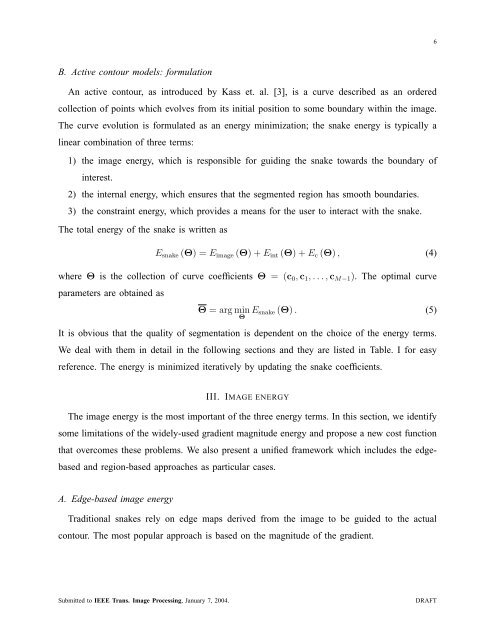Efficient energies and algorithms for parametric snakes - EPFL
Efficient energies and algorithms for parametric snakes - EPFL
Efficient energies and algorithms for parametric snakes - EPFL
You also want an ePaper? Increase the reach of your titles
YUMPU automatically turns print PDFs into web optimized ePapers that Google loves.
6B. Active contour models: <strong>for</strong>mulationAn active contour, as introduced by Kass et. al. [3], is a curve described as an orderedcollection of points which evolves from its initial position to some boundary within the image.The curve evolution is <strong>for</strong>mulated as an energy minimization; the snake energy is typically alinear combination of three terms:1) the image energy, which is responsible <strong>for</strong> guiding the snake towards the boundary ofinterest.2) the internal energy, which ensures that the segmented region has smooth boundaries.3) the constraint energy, which provides a means <strong>for</strong> the user to interact with the snake.The total energy of the snake is written asE snake (Θ) = E image (Θ) + E int (Θ) + E c (Θ) , (4)where Θ is the collection of curve coefficients Θ = (c 0 , c 1 , . . . , c M−1 ). The optimal curveparameters are obtained asΘ = arg minΘ E snake (Θ) . (5)It is obvious that the quality of segmentation is dependent on the choice of the energy terms.We deal with them in detail in the following sections <strong>and</strong> they are listed in Table. I <strong>for</strong> easyreference. The energy is minimized iteratively by updating the snake coefficients.III. IMAGE ENERGYThe image energy is the most important of the three energy terms. In this section, we identifysome limitations of the widely-used gradient magnitude energy <strong>and</strong> propose a new cost functionthat overcomes these problems. We also present a unified framework which includes the edgebased<strong>and</strong> region-based approaches as particular cases.A. Edge-based image energyTraditional <strong>snakes</strong> rely on edge maps derived from the image to be guided to the actualcontour. The most popular approach is based on the magnitude of the gradient.Submitted to IEEE Trans. Image Processing, January 7, 2004.DRAFT
















